Blower relay MITSUBISHI MONTERO 1987 1.G Workshop Manual
[x] Cancel search | Manufacturer: MITSUBISHI, Model Year: 1987, Model line: MONTERO, Model: MITSUBISHI MONTERO 1987 1.GPages: 284, PDF Size: 14.74 MB
Page 22 of 284
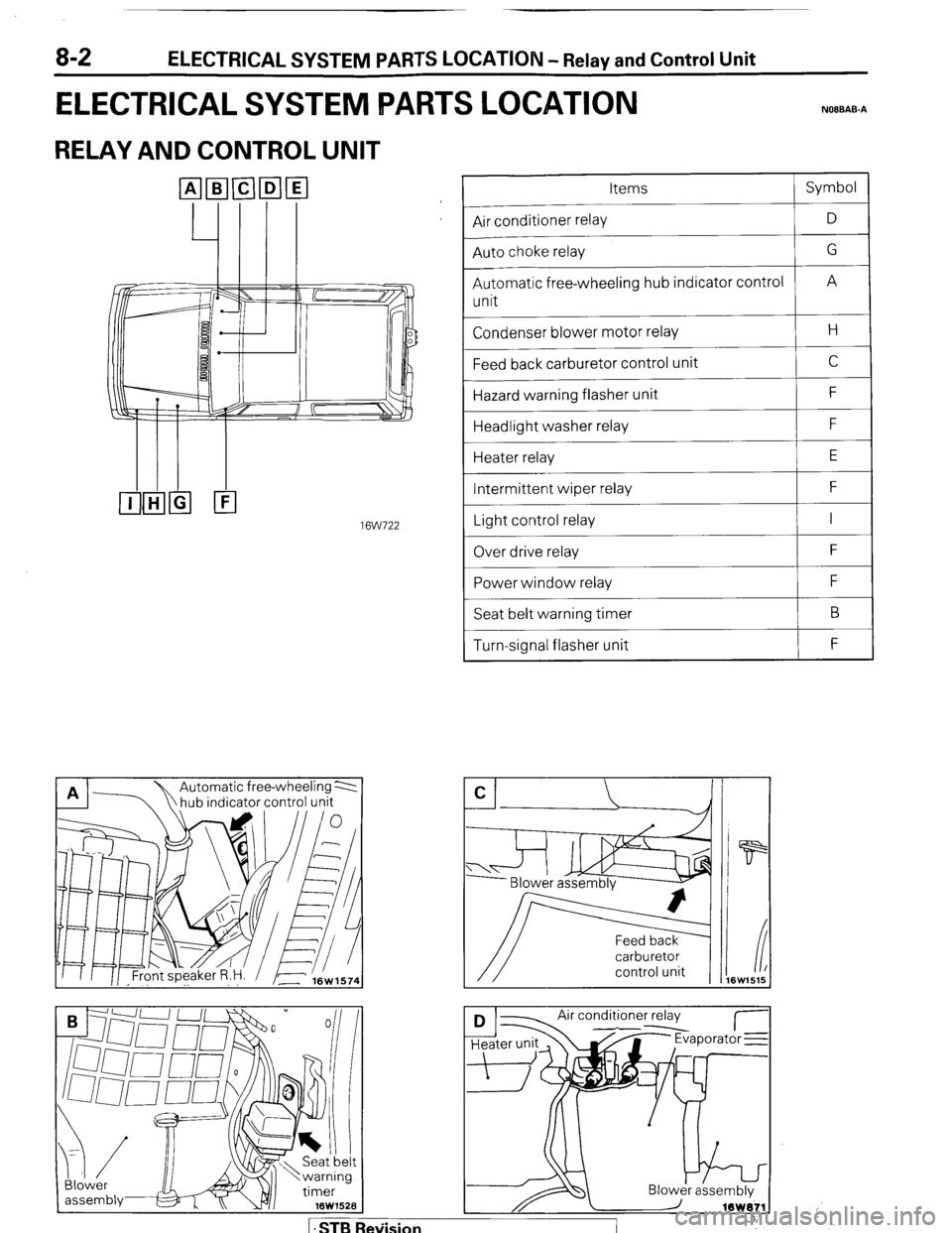
8-2 ELECTRICAL SYSTEM PARTS LOCATION - Relay and Control Unit
ELECTRICAL SYSTEM IPARTS LOCATION NOIBAB-A
RELAY AND CONTROL UNIT
16W722
n 17
hub indicator control unit A A Automatic free-wheeling 2
Blower
assembiy& x v/i 16W152B Items Symbol
--
Air conditioner relay D
--
Auto choke relay G
--
Automatic free-wheeling hub indicator control
A
unit
Condenser blower motor relay H
Feed back carburetor control unit C
Hazard warning flasher unit F
Headlight washer relay F
Heater relay E
Intermittent wiper relay F
~___
Light control relay I
~___
Over drive relay F
Power window relay F
Seat belt warning timer B
Turn-signal flasher unit F
carburetor
control unit
Air conditioner relay
d--- I- Jr Evaporator E
1 .STB Re\iision
Page 34 of 284
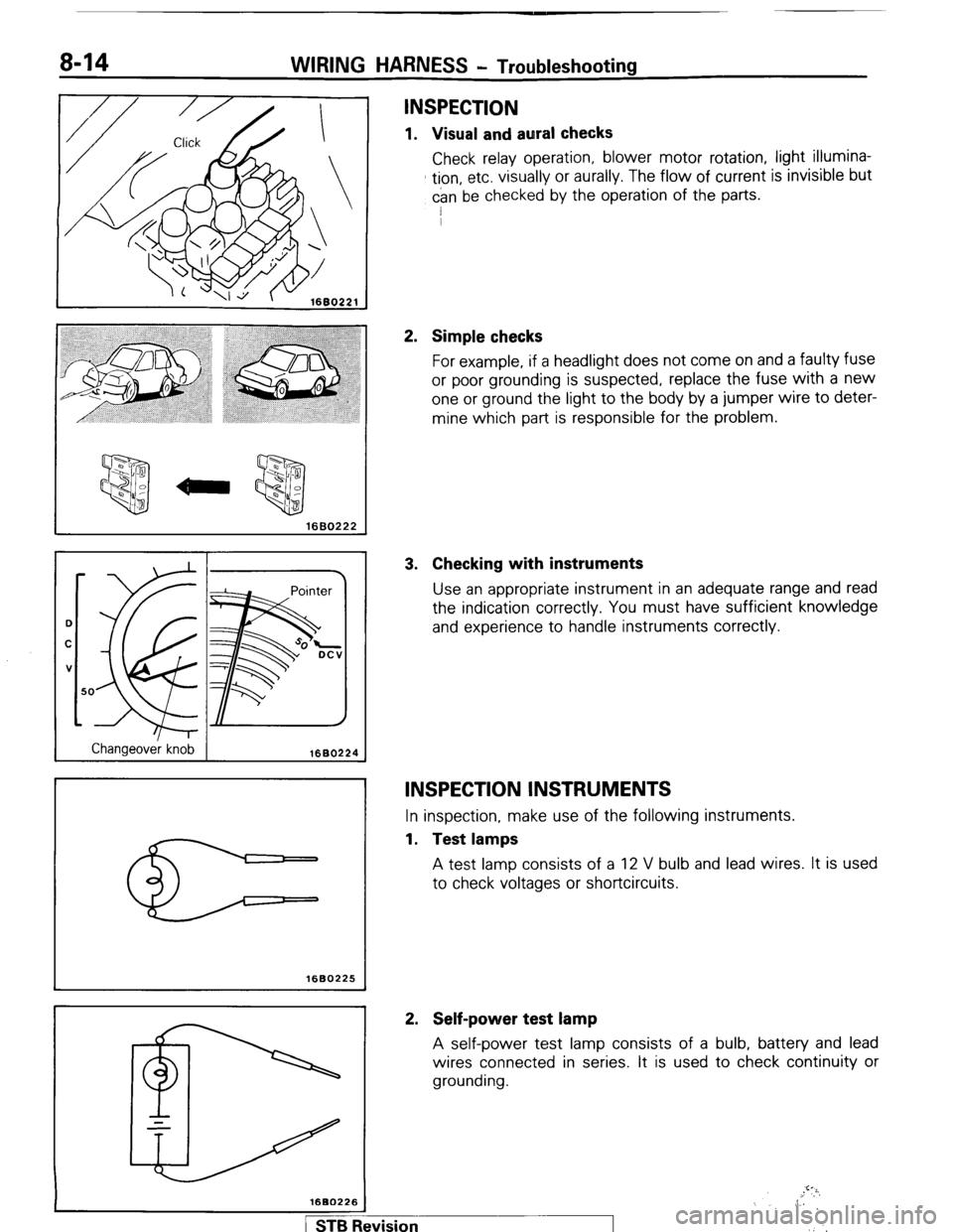
8-14 WIRING HARNESS - Troubleshooting
1680222
Changeover knob 1680224
1680225 1
1680226
INSPECTION
1. Visual and aural checks
Check relay operation, blower motor rotation, light illumina-
tion, etc. visually or aurally. The flow of current is invisible but
can be checked by the operation of the parts.
I
2. Simple checks
For example, if a headlight does not come on and a faulty fuse
or poor grounding is suspected, replace the fuse with a new
one or ground the light to the body by a jumper wire to deter-
mine which part is responsible for the problem.
3. Checking with instruments
Use an appropriate instrument in an adequate range and read
the indication correctly. You must have sufficient knowledge
and experience to handle instruments correctly.
INSPECTION INSTRUMENTS
In inspection, make use of the following instruments.
1. Test lamps
A test lamp consists of a 12 V bulb and lead wires. It is used
to check voltages or shortcircuits.
2. Self-power test lamp
A self-power test lamp consists of a bulb, battery and lead
wires connected in series. It is used to check continuity or
grounding.
,.!‘?i,
,, 6
,‘.’
1 STB Revision
Page 52 of 284
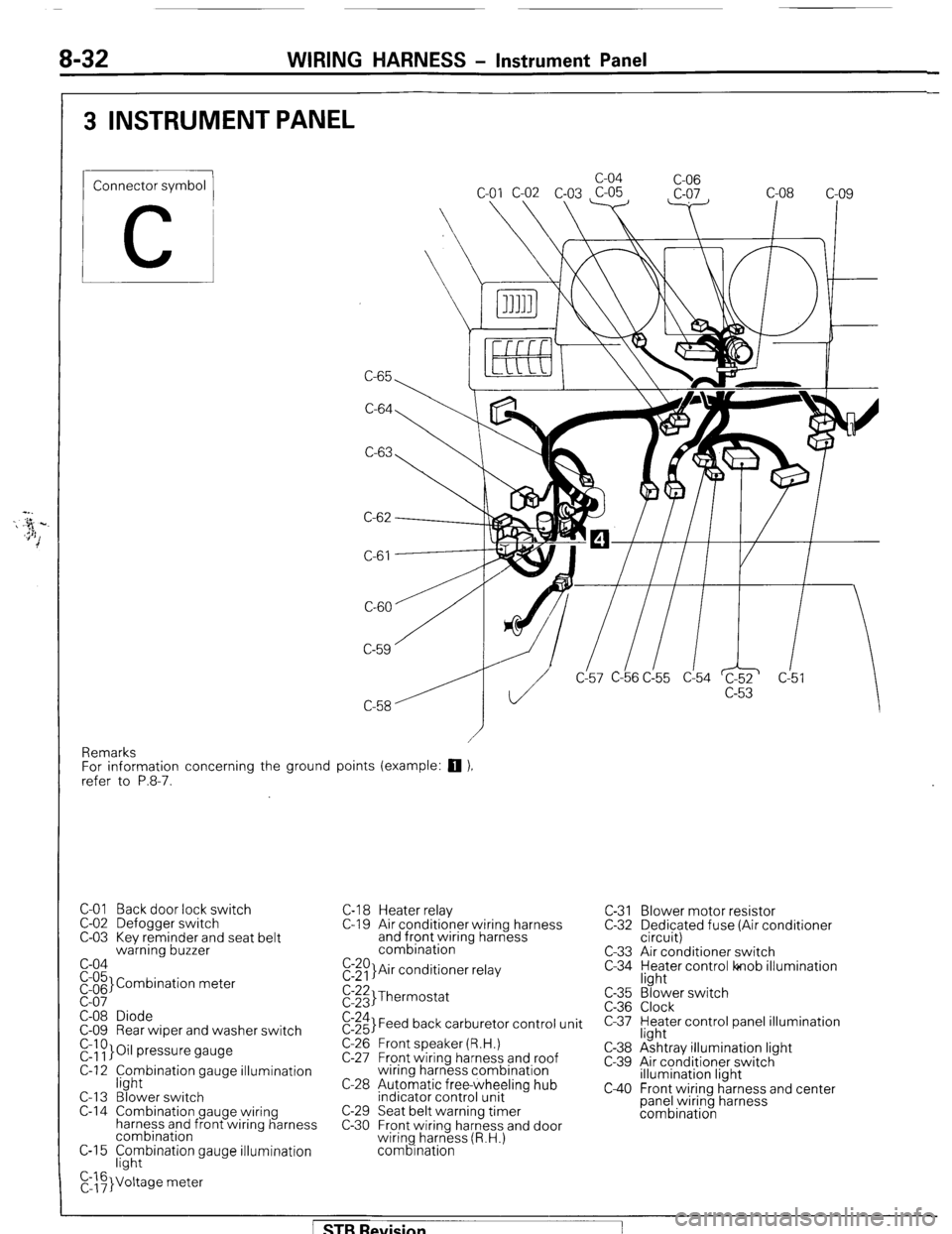
8-32 WIRING HARNESS - Instrument Panel
3 INSTRUMENT PANEL
Connector symbol
C
C-65 c-04
C-06
C-64
C-63
C-61
CL57 C-b6 C!55 d54 c!5
Remarks
For information concerning the ground points (example:
q ),
refer to P.8-7.
C-01 Back door lock switch
C-02 Defogger switch
C-03 Kev reminder and seat belt
warning buzzer
c-04
pi;’ Combination meter
C-08 Diode
C-09 Rear wiper and washer switch
r&~}Oil pressure gauge
C-12 f;hybination gauge illumination
C-l 3 Blower switch
C-14 Combination gauge wiring
harness and front wiring harness
combination
C-15 F;hybination gauge illumination
C,::F}Voltage meter C-l 8 Heater relay
C-l 9 Air conditioner wiring harness
and front wiring harness
combination
E:$)}Air conditioner relay C-31 Blower motor resistor
C-32 Dedicated fuse (Air conditioner
circuit)
C-33 Air conditioner switch
C-34 yl;Jer control lonob illumination
$:;;I Thermostat
$:;;I Feed back carburetor control unit
C-26 Front speaker (R.H.)
C-27 Front wiring harness and roof
wiring harness combination
C-28 Automatic free-wheeling hub
indicator control unit
C-29 Seat belt warning timer
C-30 Front wiring harness and door
wiring harness (R.H.)
combination c-35
C-36
c-37
C-38
c-39
c40
“3’ ‘. Blower switch
Clock
Heater control panel illumination
light
Ashtray illumination light
Air conditioner switch
illumination light
Front wiring harness and center
panel wiring harness
combination
[ STB Revision
Page 75 of 284
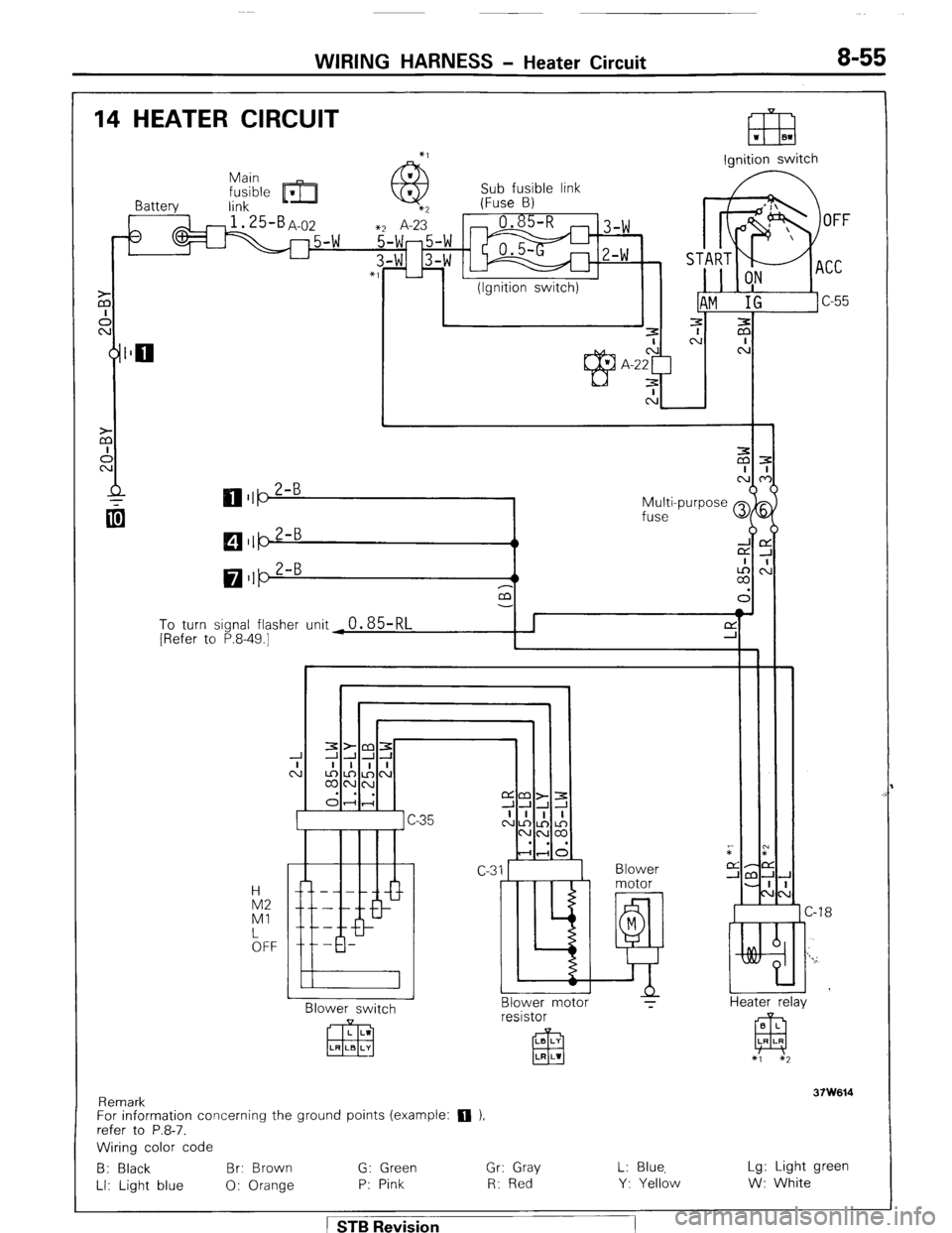
WIRING HARNESS - Heater Circuit 8-55
14 HEATER CIRCUIT
A’
Battery
0
(Ignition switch)
L
l!zEl *I BI
lonition switch
Multi-purpose
fuse
To turn signal flasher unit4 0.85-RL
[ [Refer to P.8-49.1
n
H
M2
Ml
bFF - -
P -
-
- -
I
Blower switch
Remark 37W614
For information concerning the ground points (example: 0 ),
refer to P.8-7.
Wiring color code
B: Black Br: Brown G: Green Gr: Gray L: Blue, Lg: Light green
LI: Light blue 0: Orange P: Pink R: Red Y: Yellow W: White Blower motor
resistor
LB LI
El3 LR LW
Blower
motor
M
!! T i
C-18
I
Heater relay
8 L
El LR LR
*1 *2
STB Revision
Page 76 of 284
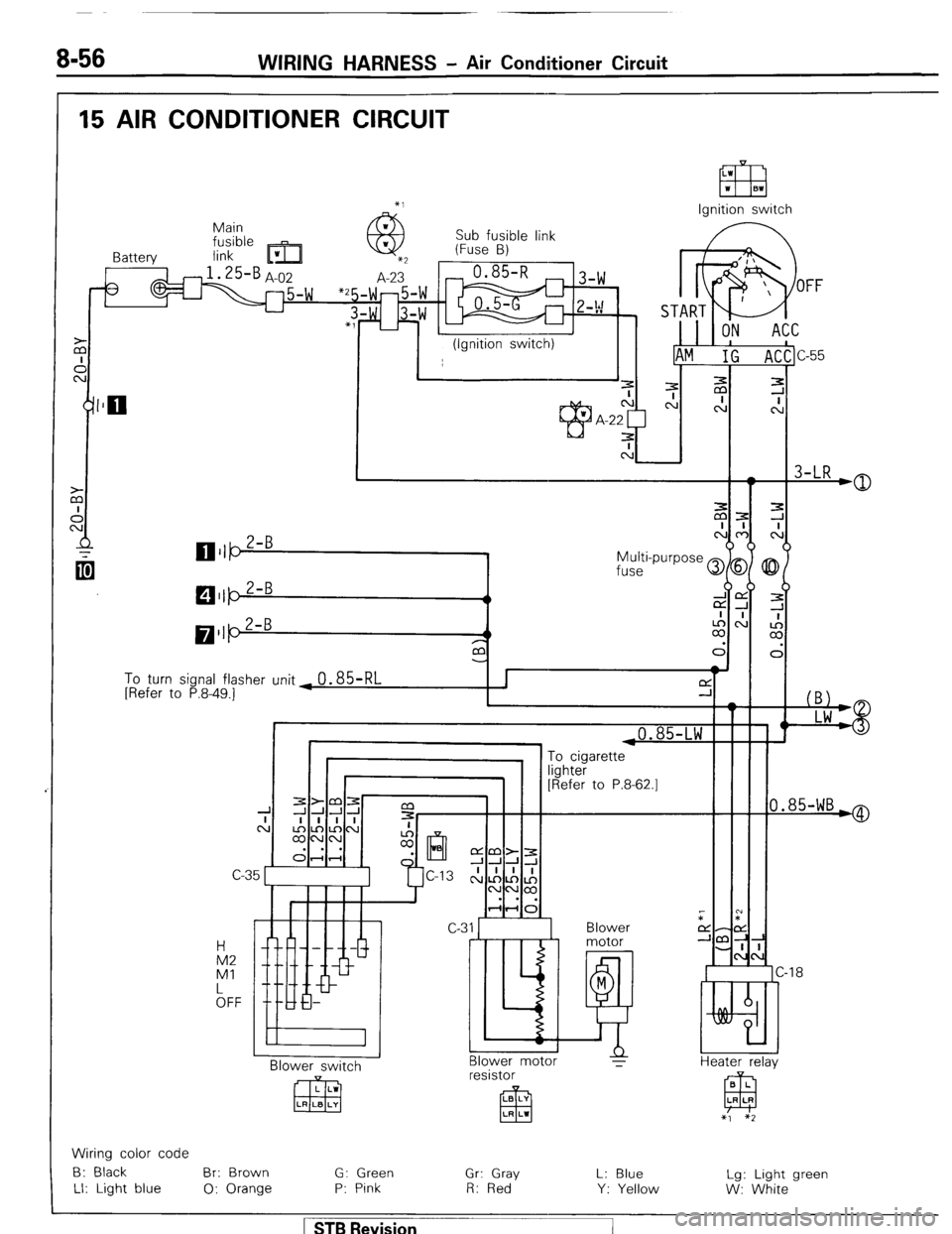
8-56 WIRING HARNESS - Air Conditioner Circuit
15 AIR CONDITIONER CIRCUIT
Main
fusible m
I;..,, 1 Ignition switch
Sub fusible link
(Fuse B)
+2 0.85-R
I I
(lonition switch)
I I ,!..I ’ ’
T
3-LRwQ
To turn signal flasher unit ~ 0.85-RL [Refer to P.849.1 J
L
I
I , ,0.85-LW
FA2 Ml
bFF To cigarette
lighter
[Refer to P.8-62.1
I f Y
Blower
motor
8 I
M
4JY motor
T-
Ii
1
Blower switch lower 1C-18 l!!!a Heater relay
0.85-WB@
Wiring color code
B: Black Br: Brown
G: Green
Gr: Gray L: Blue Lg: Light green
LI: Light blue
0: Orange P: Pink I?: Red
Y: Yellow W: White -
STB Revision
II/
Page 77 of 284
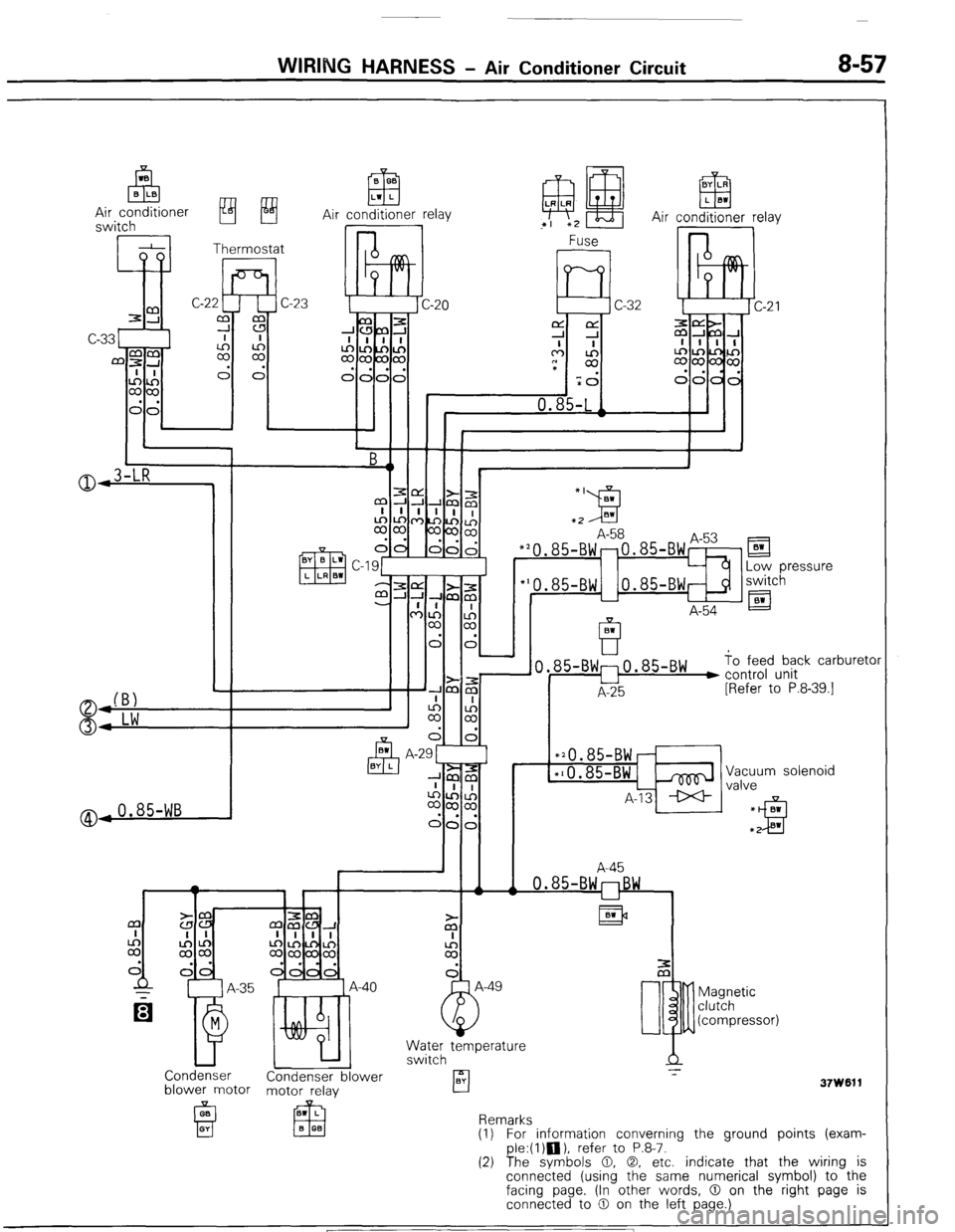
WIRING HARNESS - Air Conditioner Circuit 8-57
0
(Bl
0: Lw
@,0.85-WB B 0.3
ElFI Lvf L
Air conditioner relay I @ H ‘I *2 Air :on!$!er rela
85-Bw:o.85-Bw ) to feed back carburetor
u control unit
A-25 [Refer to P.8-39.1
l 20.85-BWr
l 10.85-BWL&
A-13 * Vacuum solenoid
valve
A-45
0.85-BWnBW
Is*la
Magnetic
clutch
(compressor)
U
Water temperature
switch
Condenser
Condenser blower -I-
BY
blower motor motor relay rl
37W611
Remarks
(1) For information converning the ground points (exam-
ple:(l)n), refer to P.8-7.
(2) The svmbols 0, 0, etc. indicate that the wiring is
connedted (using the same numerical symbol) to-the
facing page. (In other words, 0 on the right page is
connected to 0 on the left page.) ) STB Revision
Page 98 of 284
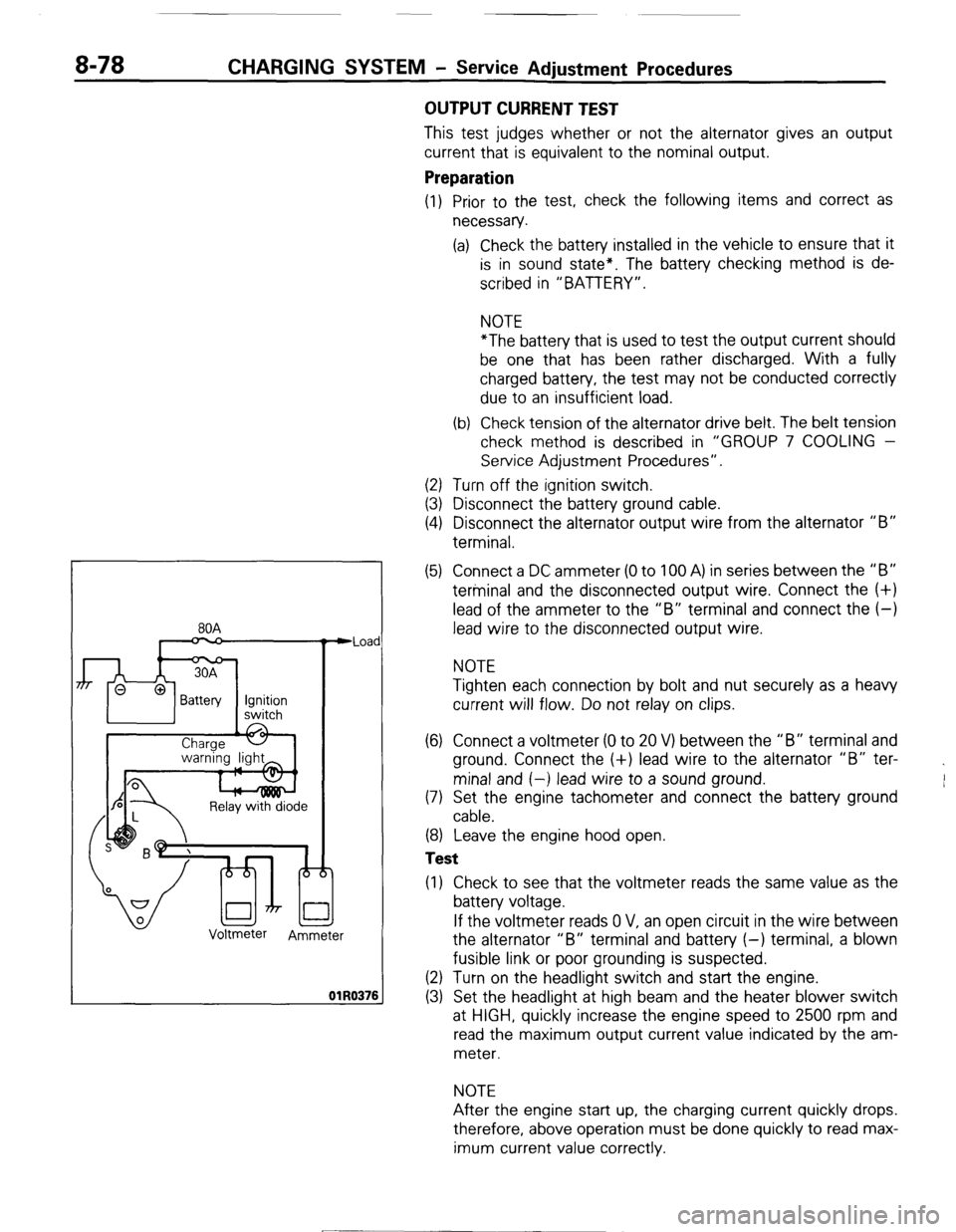
8-78 CHARGING SYSTEM - Service Adiustment Procedures
80A
n
Relay with diode
Voltmeter
Ammeter Iad
176
OUTPUT CURRENT TEST
This test judges whether or not the alternator gives an output
current that is equivalent to the nominal output.
Preparation
(1) Prior to the test, check the following items and correct as
necessary.
(a) Check the battery installed in the vehicle to ensure that it
is in sound state*. The battery checking method is de-
scribed in “BATTERY”.
NOTE
*The battery that is used to test the output current should
be one that has been rather discharged. With a fully
charged battery, the test may not be conducted correctly
due to an insufficient load.
(b) Check tension of the alternator drive belt. The belt tension
check method is described in “GROUP 7 COOLING -
Service Adjustment Procedures”.
(2) Turn off the ignition switch.
(3) Disconnect the battery ground cable.
(4) Disconnect the alternator output wire from the alternator “B”
terminal.
(5) Connect a DC ammeter (0 to 100 A) in series between the “B”
terminal and the disconnected output wire. Connect the (+)
lead of the ammeter to the “B” terminal and connect the (-)
lead wire to the disconnected output wire.
NOTE
Tighten each connection by bolt and nut securely as a heavy
current will flow. Do not relay on clips.
(6) Connect a voltmeter (0 to 20 V) between the “B” terminal and
ground. Connect the (+) lead wire to the alternator “B” ter-
minal and (-) lead wire to a sound ground.
(7) Set the engine tachometer and connect the battery ground
cable.
(8) Leave the engine hood open.
Test
(1) Check to see that the voltmeter reads the same value as the
battery voltage.
If the voltmeter reads 0 V, an open circuit in the wire between
the alternator “B” terminal and battery (-) terminal, a blown
fusible link or poor grounding is suspected.
(2) Turn on the headlight switch and start the engine.
(3) Set the headlight at high beam and the heater blower switch
at HIGH, quickly increase the engine speed to 2500 rpm and
read the maximum output current value indicated by the am-
meter.
NOTE
After the engine start up, the charging current quickly drops.
therefore, above operation must be done quickly to read max-
imum current value correctly.
[ STB Revision
--I
Page 213 of 284
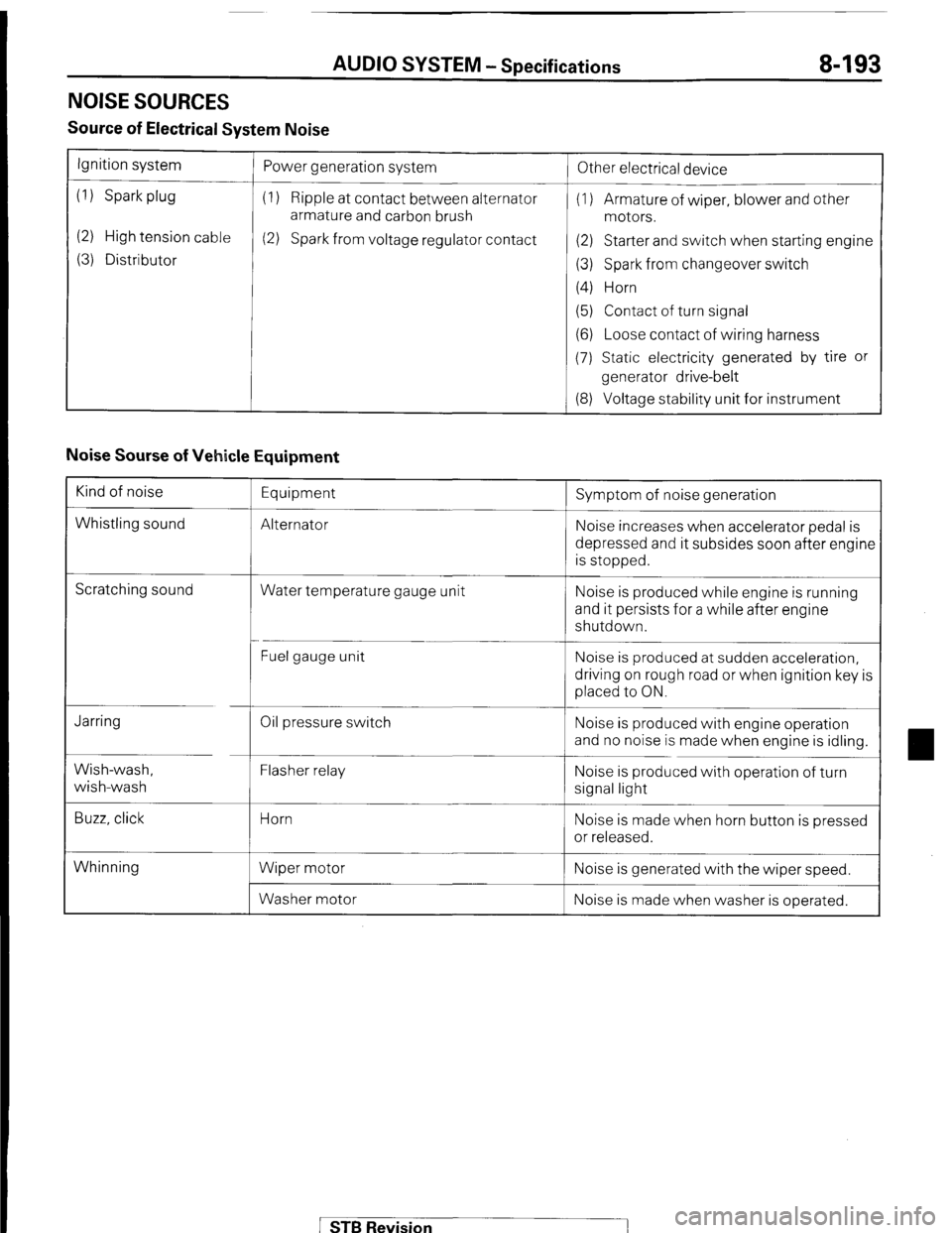
AUDIO SYSTEM - Specifications 8-193
NOISE SOURCES
Source of Electrical System Noise
Ignition system
(1) Spark plug
(2) High tension cable
(3) Distributor Power generation system
(1) Ripple at contact between alternator
armature and carbon brush
(2) Spark from voltage regulator contact
!
Other electrical device
(1) Armature of wiper, blower and other
motors.
(2) Starter and switch when starting engine
(3) Spark from changeover switch
(4) Horn
(5) Contact of turn signal
(6) Loose contact of wiring harness
(7) Static electricity generated by tire or
generator drive-belt
(8) Voltage stability unit for instrument
Noise Sourse of Vehicle Equipment
Kind of noise
Whistling sound Equipment
Alternator Symptom of noise generation
Noise increases when accelerator pedal is
depressed and it subsides soon after engine
is stopped.
Scratching sound
Water temperature gauge unit Noise is produced while engine is running
and it persists for a while after engine
shutdown.
Fuel gauge unit Noise is produced at sudden acceleration,
driving on rough road or when ignition key is
placed to ON.
Jarring
Wish-wash,
wish-wash
Buzz, click Oil pressure switch
Flasher relay
Horn
Wiper motor
Washer motor Noise is produced with engine operation
and no noise is made when engine is idling.
Noise is produced with operation of turn
signal light
Noise is made when horn button is pressed
or released.
Whinning Noise is generated with the wiper speed.
Noise is made when washer is operated.
STB Revision
Page 258 of 284
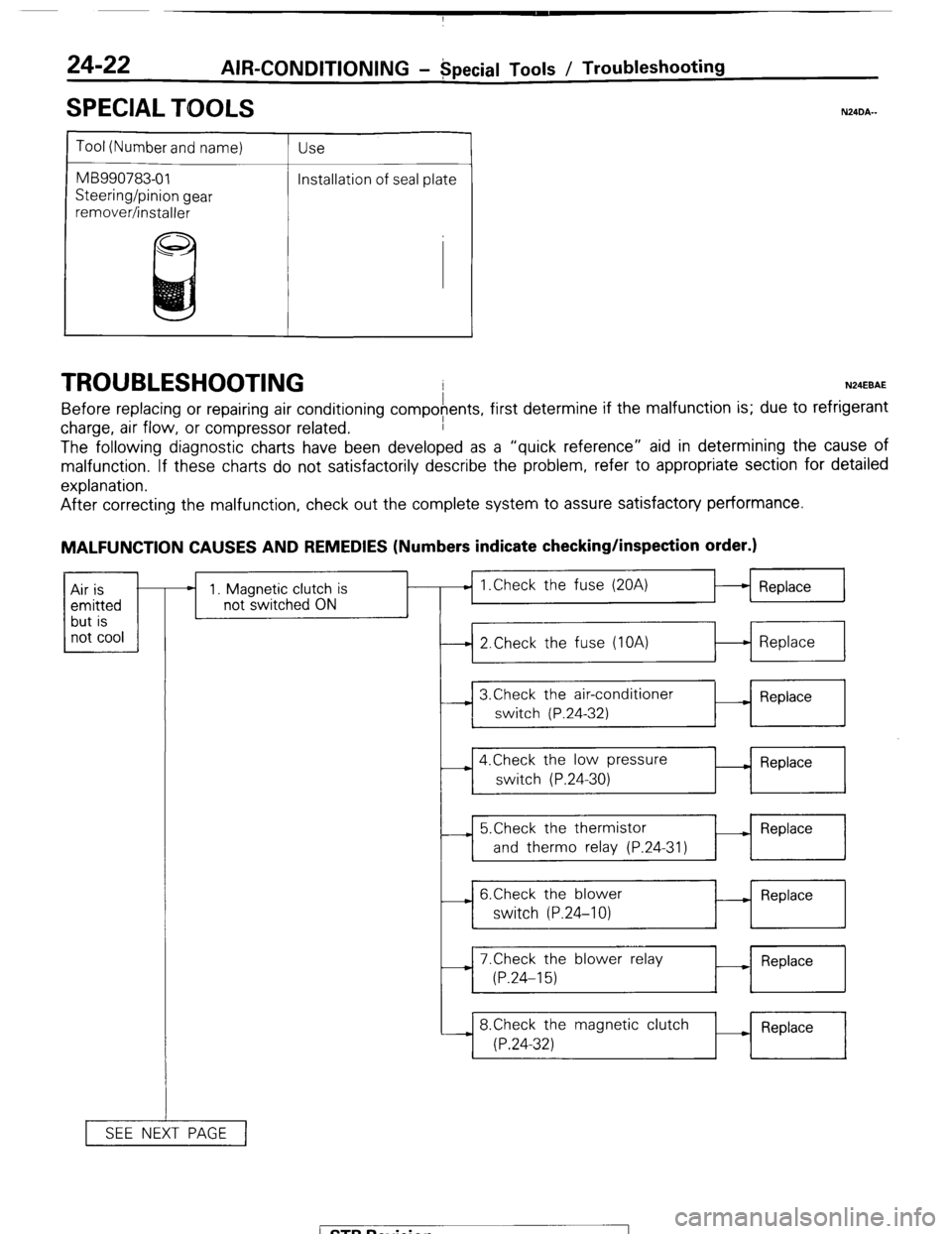
24-22 AIR-CONDITIONING - Special TOOIS / Troubleshooting
SPECIAL TOOLS
Tool (Number and name)
MB990783-01
Steering/pinion gear
remover/installer Use
Installation of seal plate
TROUBLESHOOTING N24EBAE
Before replacing or repairing air conditioning compofents, first determine if the malfunction is; due to refrigerant
charge, air flow, or compressor related.
The following diagnostic charts have been developed as a “quick reference” aid in determining the cause of
malfunction. If these charts do not satisfactorily describe the problem, refer to appropriate section for detailed
explanation.
N24DA.-
After correcting the malfunction, check out the complete system to assure satisfactory performance.
MALFUNCTION CAUSES AND REMEDIES (Numbers indicate checking/inspection order.)
1 not cool 1 Air is
emitted
but is * 1. Magnetic clutch is
not switched ON
SEE NEXT PAGE 1 Replace
1
I
I I
-4 2.Check the fuse (IOA)
t-l Replace
I
I I
I ,
I
3,Check the air-conditioner
__) Replace
switch (P.24-32)
I
4.Check the low pressure
switch (P.24-30) - Replace
---L 5.Check the thermistor
- Replace
and therm0 relay (P.24-31)
- 6.Check the blower
switch (P.24-10) - Replace
-i 7.Check the blower relay
M Replace
(P.24-15)
8.Check the magnetic clutch
(P.24-32) Replace
I
1 STB Revision
Page 261 of 284
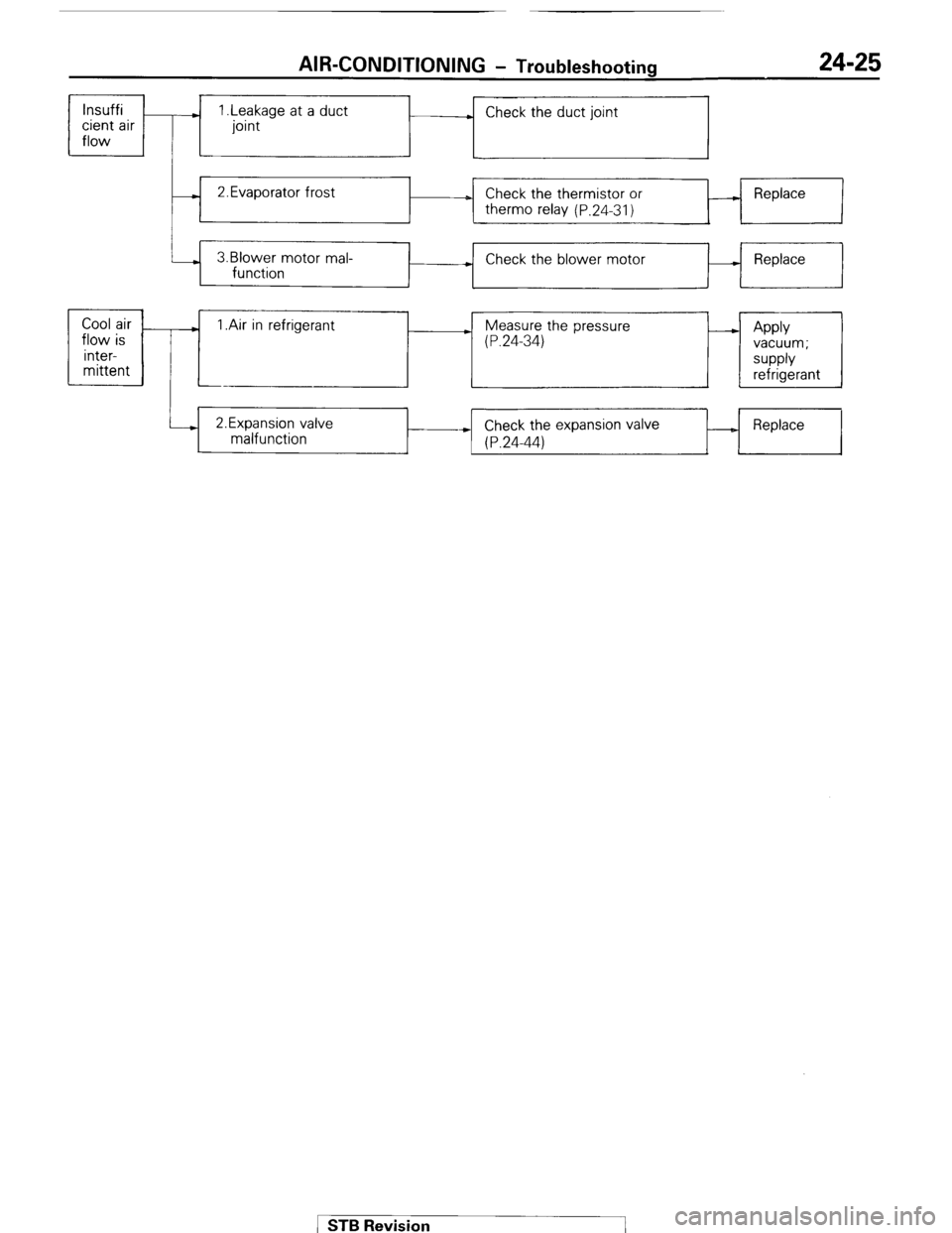
AIR-CONDITIONING - Troubleshooting 24-25
lnsuffi
cient air
flow ) 1 .Leakage at a duct
joint . Check the duct joint
- 2.Evaporator frost
D Check the thermistor or
therm0 relay (P.24-31) A Replace
3.Blower motor mal-
function + Check the blower motor - Replace
+
Cool air
.
flow is 1 .Air in refrigerant ) Measure the pressure
(P.24-34) - Apply
inter- vacuum;
mittent supply
refrigerant
i--) 2.Expansion valve
malfunction Check the expansion valve
* (P.24-44) _ Replace STB Revision